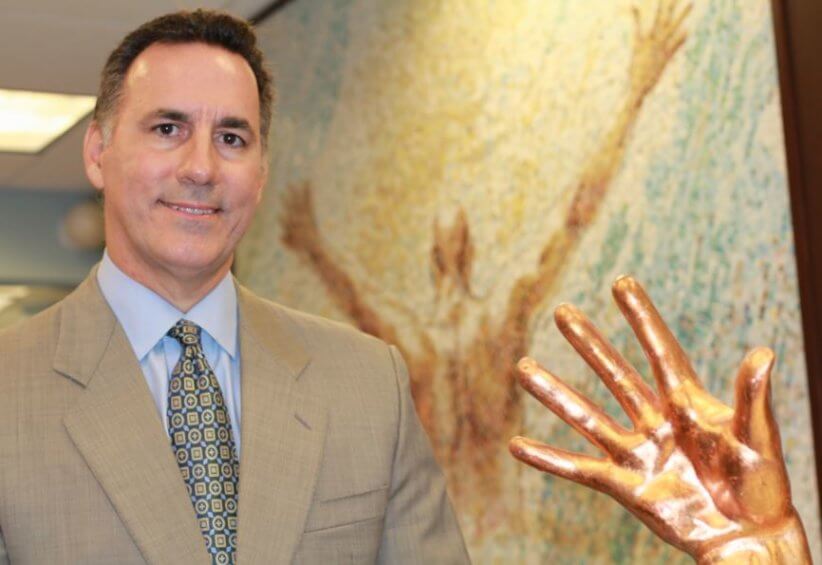
Alejandro Badia, M.D., explains de Quervain’s tenosynovitis, a thumb-tendon disorder many moms experience.
Becoming a mother has its share of joys and challenges. Now it seems like it has its share of pain as well, specifically for women with de Quervain’s tenosynovitis, a thumb-tendon disorder. The disorder can mean sheer pain, according to orthopedic surgeon Alejandro Badia, M.D., who says the condition limits a person’s ability to grasp, grip, and pinch; inhibits the use of the hand; and limits the range of motion in the wrist.
Mommy wrist
De Quervain’s tenosynovitis is characterized by inflammation and swelling of two main tendons that pass through a narrow tunnel located on the thumb side of the wrist and control thumb movement, explains Badia. He is a specialist in treating musculoskeletal disorders of the hands, wrists, and other upper limbs.
Named after Swiss surgeon Fritz de Quervain, the disorder is sometimes referred to as “mommy wrist” because it occurs eight-to-10 times more frequently in women and its development is linked to post-partum hormonal- and fluid-shift changes — not to activities involving carrying, changing or feeding the new baby, as some experts contend, Badia states.
“Hormonal changes after a woman gives birth can lead to thickening and water retention of the tenosynovium, the sheath covering the thumb’s tendons, which are located in what is an anatomically-tight tunnel or compartment,” he says.
Experts concur. For example, authors of a report in the journal, Hand, contend that “soft-tissue edema, fluid retention, and ligamentous laxity are common effects of pregnancy, [and these] can impact the [body’s] inflammatory response” and lead to conditions like thumb tendonitis.
The American Academy of Orthopaedic Surgeons describes tendons as “rope-like structures that attach muscle to bone and are covered by a slippery thin soft-tissue layer — the synovium.” The synovium is what enables the thumb tendons to glide readily through the tunnel. Any swelling or thickening of the tendons impacts their movement and can cause pain, says Badia.
Symptoms and treatment
Common symptoms of the disorder are pain and swelling at the base of the thumb or on the thumb side of the wrist, a sensation of “sticking” or “snapping” when moving the thumb and difficulty or pain, including pain that travels up the forearm, when attempting to grasp or “pinch” something forcefully. Physicians can diagnose the problem using ultrasound or simply applying physical pressure to the affected area by causing deviation of the wrist while maintaining the patient’s thumb in a fully flexed position, a technique called Finkelstein’s test.
Some scientists believe that advanced technology, including frequent use of the thumb to punch out text messages or play video games, is one reason for a growing prevalence of de Quervain’s tenosynovitis — or tendonitis. At least one medical journal has referred to the problem as “texting tenosynovitis.” But repetitive movements involving the thumb, including work-related activities like extended typing on a computer keyboard, gardening, and carpentry are less a “cause” of the disorder and more an “aggravation of a painful condition that is already present,” Badia says.
Conservative therapy approaches such as anti-inflammatory medications, corticosteroid injections, and splinting are normally the first lines of treatment for the condition. However, surgery may be required in cases of persistent disease and pain, Badia says. Most recently, in a December 2019 study published in Musculoskeletal Surgery, investigators state that “surgical release of de Quervain’s tenosynovitis remains the gold standard treatment.”
Badia agrees. “The surgical procedure is easy to perform and readily done on an outpatient basis.” Recovery is quick, with patients having immediate use of their hand, although the return to heavy manual work or sports-related activities, including workouts in the gym, might be delayed two-to-three weeks,” he states.
Prevention
Of course, the best treatment for de Quervain’s tenosynovitis is prevention, Badia says. He offers these tips to limit risk for developing the disease:
• Avoid awkward or unnatural wrist positions and alignments when engaged in work or recreational activities.
• Take frequent breaks from tasks requiring repetitive movement.
• Do exercises to enhance the strength and mobility of wrist joints and hands.
• Use other fingers, not just the thumb, for keystrokes when typing or texting.
• Follow the guidelines of good nutrition and get ample sleep. A healthy lifestyle helps keep joints, ligaments, and tendons lubricated and can provide them with the necessary nutrients to repair and rebuild themselves.
“Above all, for any joint problems or other musculoskeletal disorder, contact an orthopedic specialist,” Badia emphasizes.
Alejandro Badia, M.D., FACS, is a hand and upper-limb surgeon and founder of Badia Hand to Shoulder Center and OrthoNOW®, a walk-in orthopedic care clinic. He specializes in treating all problems related to the hand and upper extremities. drbadia.com.













